Peec is billed as a platform for tracking AI search analytics and improving brand performance on AI search platforms. At a glance, the platform appears to have a sleek UI, accessible analytics, and relatively low pricing.
But does it live up to the marketing hype? How does it compare to other top AI visibility tools? And can it really help you monitor and improve visibility in AI search?
I tested Peec to answer these questions and (and many more). I’ll walk you through my experience in this Peec review.
Peec AI review TL;DR
- Peec offers basic AI visibility, position, and sentiment metrics for your brand and your top competitors, helping you understand how your brand performs and competes in AI search.
- It’s one of the most affordable AI visibility platforms, at least when you consider the starting price. But between the add-ons and the missing tools, you may end up spending more to get the functionality you need.
- It’s a tool designed for monitoring, not for action. If you want a solution that tracks AI visibility, offers strategic recommendations, and creates content to support those suggestions, you’d need to look elsewhere.
Pros and cons of Peec AI
Here’s a quick overview of where Peec shines and where it has room for improvement.
Peec pros
- Simplicity: If you’re new to AI SEO or if you’re looking for a straightforward tool to get your team started, Peec might fit the bill. It offers AI visibility, position, and sentiment data, giving you a quick and easy overview of brand performance.
- Competitive insights: The platform benchmarks your brand against your top competitors. This means you can easily track who’s winning and take steps to improve your visibility, position, and sentiment.
- Agency support: Agencies can scale their AI SEO services using the platform’s pitch workspaces. They let you add new brands with a limited number of prompts so you can use the data to win new clients.
- Pricing: Peec has one of the lowest starting prices in the category. For €89 per month (roughly $103 per month as of when this article’s publish date) , you can track up to 25 prompts and analyze up to 2,250 AI answers. The platform also offers enterprise plans with custom limits and capabilities.
Peec cons
- Limited insights: Peec has plenty of data to share. But it’d be up to you to decide how to interpret the information you see on your dashboard. The platform doesn’t offer insights, comparative data, or recommendations for what to do next.
- Lack of workflows: If you do end up deciding to act on the data, Peec won’t help you with next steps. The platform doesn’t offer content generation or optimization assistance, so you’d need a separate tool or team to do the work.
- No AI crawler data: Peec tracks AI mentions and citations for your brand across synthetic prompts sent out, but it doesn’t tell you how AI bots actually interact with your website limiting your ability to understand how referred traffic performs or connect revenue.
- Climbing costs: The platform’s extras can add up quickly. AI engines beyond ChatGPT, Perplexity, and Google AI Overviews require an additional fee. And if you need to track more than 25 prompts or analyze more than 2,250 AI answers per month, you’d need to upgrade to a higher tier plan or the enterprise option.
Peec fundraising
As of November 2025, Peec AI has had two funding rounds. The first seed round in April 2025 raised $1.95 million, and the second, led by 20VC, raised $6.13 million in July 2025.
In contrast, Profound is growing much faster, having raised over $58 million across three funding rounds. The August 2024 seed round raised $3.5 million. In June 2025, the Series A round raised $20 million, led by Kleiner Perkins. Then in August 2025, Profound announced a $35 million Series B round, led by Sequoia Capital.
Peec AI walkthrough
Let’s look at how Peec works and how it compares to Profound.
Prompts
When setting up Peec, the first thing you do is choose prompts to analyze. The platform automatically suggests prompts based on your website.
But in my experience, this process leaves a lot to be desired. For example, here’s the prompt list it suggested for Profound:

There are relevant prompts in the list, but Peec doesn’t quantify search volume or show you which prompts are increasing or decreasing in popularity.
The color coded bars in the “Volume” column reflect prompt volume on a scale of one (very low interest) to five (very high interest). Does very high indicate 1,000 or 1 million searches? That’s anyone’s guess, since Peec doesn’t give numbers for prompt volumes.
I spoke with a marketing specialist at a major transportation company in Europe who noted, “We were totally dissatisfied with the search volumes. [Peec] doesn't have that option. They don’t provide any kind of accurate volumes.”
All of this makes choosing what to track to get comprehensive coverage for your brand very difficult. And since all Peec plans have strict prompt limits (25 for the entry-level Starter plan and 100 for the mid-level Pro plan) it’s important to pick the right ones.
While you can add prompts individually or via bulk upload, this process assumes you’ve already done some AI search engine analysis. If you’re approaching it from an SEO mindset (i.e., with a keyword list), you’re going to have to do extra work (and use a separate tool) to create a prompt list.
And that “Add Topic” button you see at the top of the Peec dashboard? It’s just a manual organization feature. You input topic names and use them to categorize your prompts.
With Profound, however, it’s easy to explore and identify relevant prompts. All you have to do is type a keyword into the “Prompt Volumes” search and it’ll suggest relevant ones with actual search volume. There’s no need to engineer any prompts.
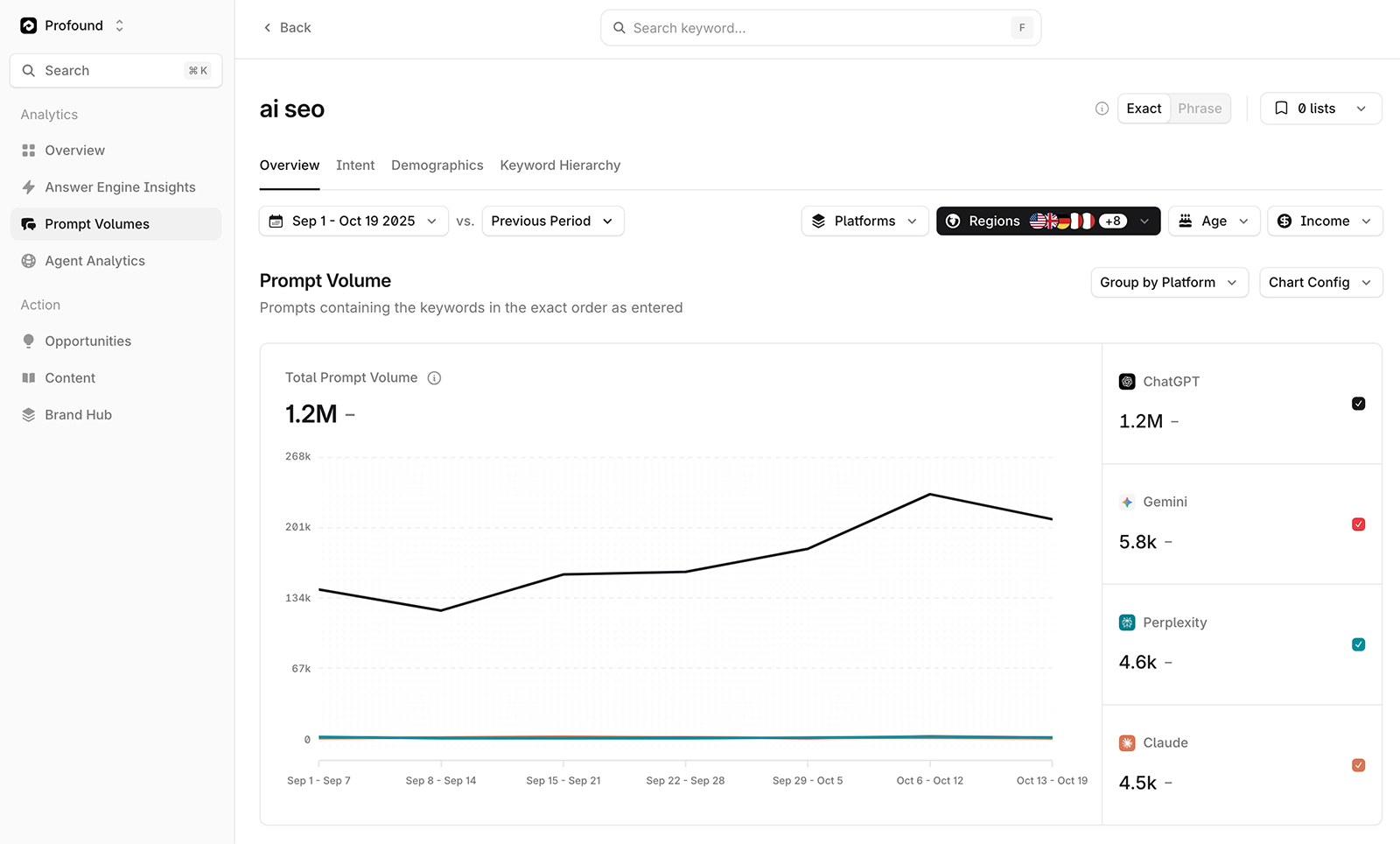
From there, Profound gives you a sense of the volume across different AI engines and the user intent behind the keyword. This helps you understand which AI platforms to optimize for and what people are seeking across information, consideration, conversation, or generation.
Plus, you can review a list of relevant user prompts to see what people are actually asking in relation to the keyword. And you can add the keyword to a list so you can continue to monitor relevant prompts with Profound over time.
Visibility
Once you’ve chosen prompts to monitor, you need to know if your brand is getting mentioned or cited in relevant conversations. Peec tracks visibility by measuring the percentage of relevant chats that mentioned your brand in the past week.
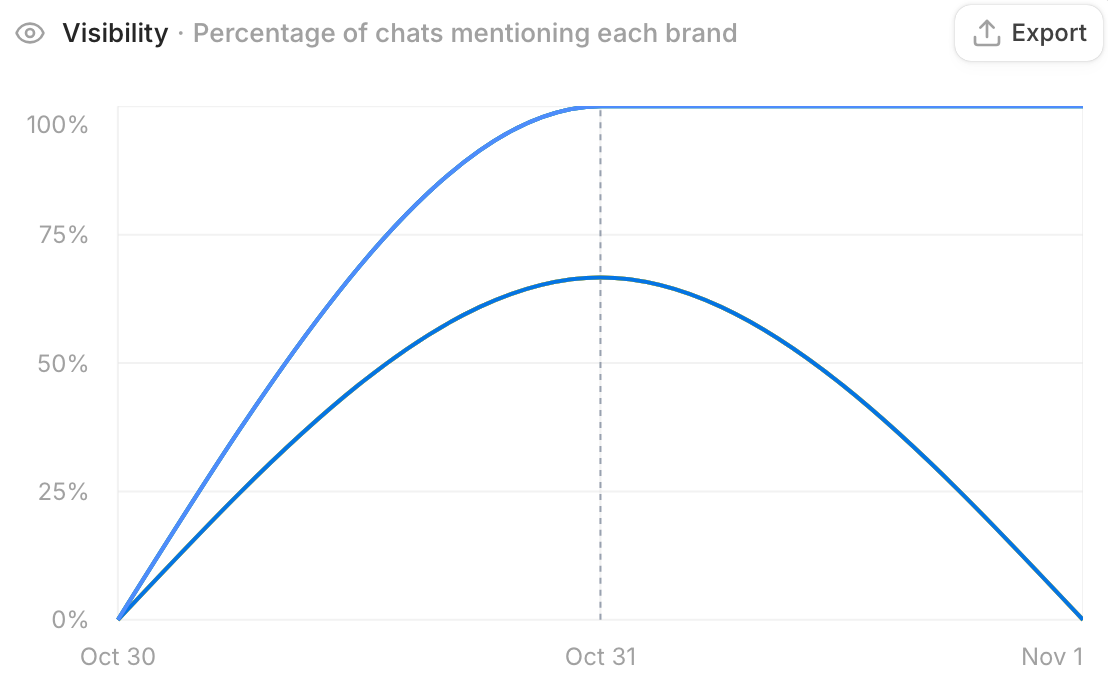
While this gives you a basic idea of where your brand stands now, it’s pretty simplistic—especially if you want to understand the bigger picture.
Profound measures this metric two ways. The visibility score reflects how often your brand is mentioned across prompts over the past week. The dashboard includes comparative metrics so you can see how your Visibility Score has changed week over week.

And Profound’s share of voice reflects how your brand gets mentioned in AI answers compared to other brands in your space. It gives you deeper insight into how well your brand appears in AI answers, along with comparative insights to see how this metric has changed over time.
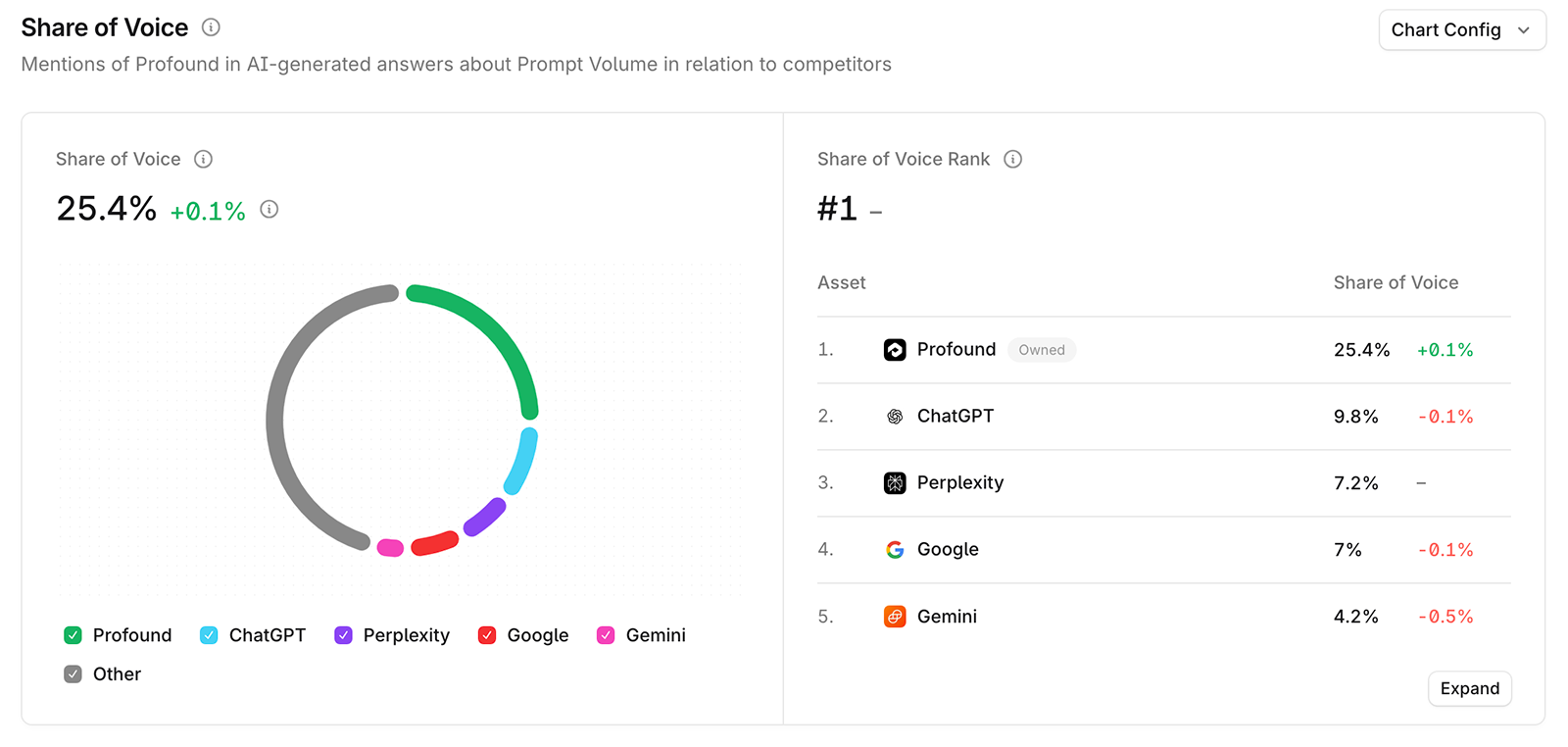
Sentiment
AI engines might be picking up conversations about your brand. But are those mentions positive, negative, or neutral?
Peec provides a sentiment score that indicates the overall tone of the AI mentions for each prompt. It looks for positive terms (e.g., “reliable” and “leading”) and critical language to rate sentiment on a scale of 0 to 100.

Profound provides an overall sentiment score that shows how feelings about your brand have changed across prompts. It also highlights both positive and negative terms that frequently pop up so you can see what’s driving sentiment at a glance.

Sources
To improve your AI visibility, you need to know which websites AI platforms are mentioning or citing. Peec tracks sources for every prompt. It labels source types (e.g., “UGC” or “Corporate”) so you can easily see the nature of the sources related to each prompt.

You can click on any source to get a full list of relevant URLs. Each URL flags mentions of your brand or your competitors.
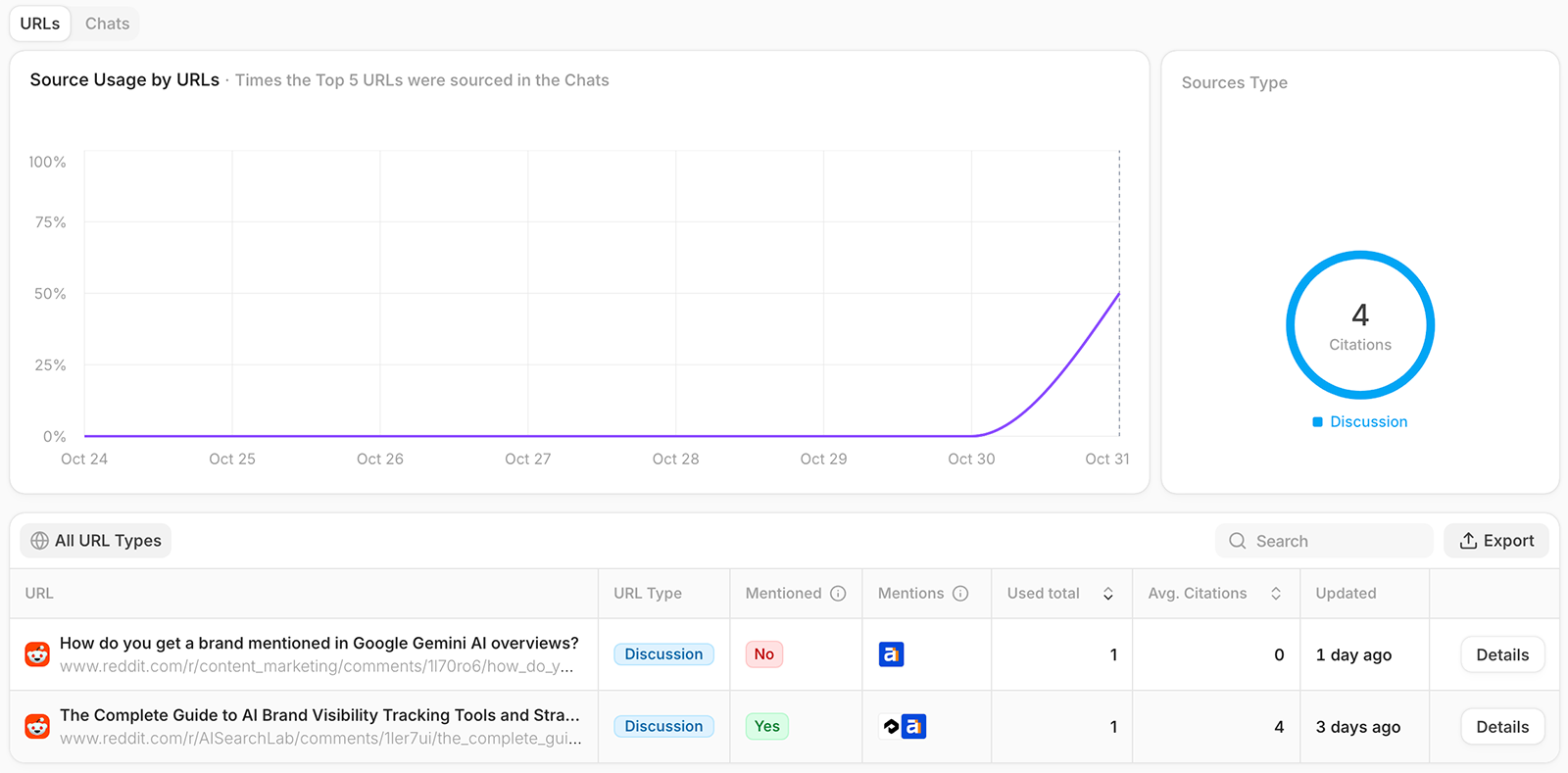
As helpful as these details are for understanding what AI platforms are citing, they don’t tell you how people are prompting AI engines. For that, you have to check the “Chats” tab, which shows related prompts and responses.

Profound takes this a step further. For every prompt, the Answer Engine Insights tool lists actual AI responses, highlighting where your brand appears in the answer.
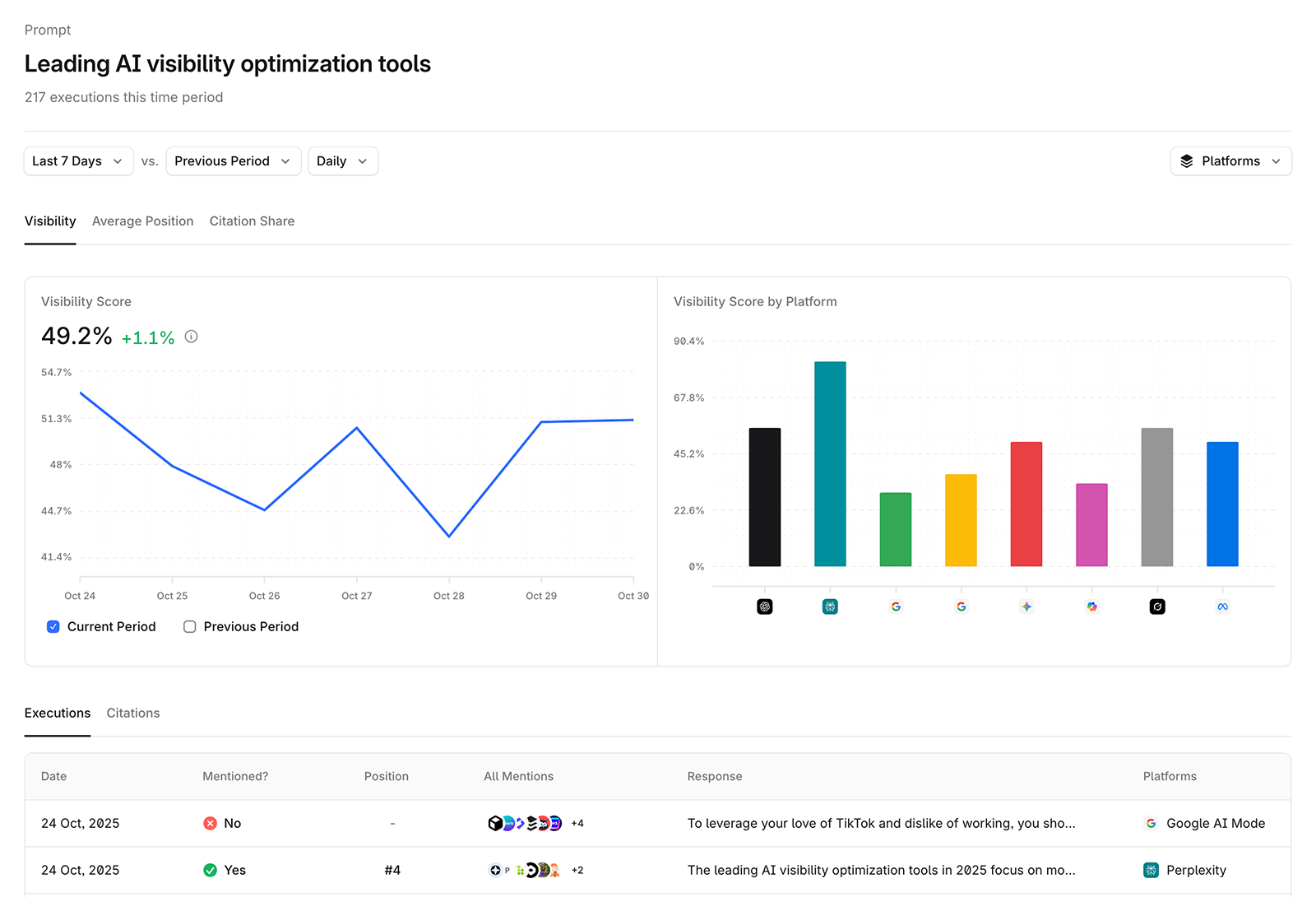
It also lists all mentioned competitors and provides citations so you can see exactly which webpages contributed to the AI engine’s response.

Competitors
AI SEO doesn’t function in a bubble. To improve your visibility, you need to know how your rankings compare to your competitors.
Peec provides basic competitive data, showing you how you compare to other brands in your space in terms of visibility, sentiment, and position.

Profound’s competitive insights go deeper. In addition to visibility, position, and share of voice comparisons, the platform also lets you compare visibility rankings across topics and prompts at a glance.

Optimizations
Now that you know how your AI visibility rates, what do you do with the information?
Peec leaves the strategic part up to you. The platform doesn’t recommend next steps, so you have to use your judgment to decide how to act on those sources. For example:
- If a competitor frequently appears in the source list for a key prompt, you might take a deep dive into their content strategy and reverse engineer it.
- If an industry publication is cited frequently, you might reach out to learn how you can get your brand included in their upcoming content.
If you need to generate outlines, content drafts, or outreach emails, you’re on your own. And you have to use a separate platform.
Another marketing manager in the B2B services industry I spoke with noted this as well, saying “This is where Peec lacks. It's just a measurement tool at this point if that.”
In contrast, Profound identifies and shares opportunities to improve your AI visibility. Each one includes specific recommendations, including implementation steps, rationale for completing the optimization (which you can share with your team) and references to aid your research.

Plus, Profound has a built-in content generation engine. Select any content optimization or creation opportunity and ask Profound to generate a fully researched and optimized content brief in minutes.
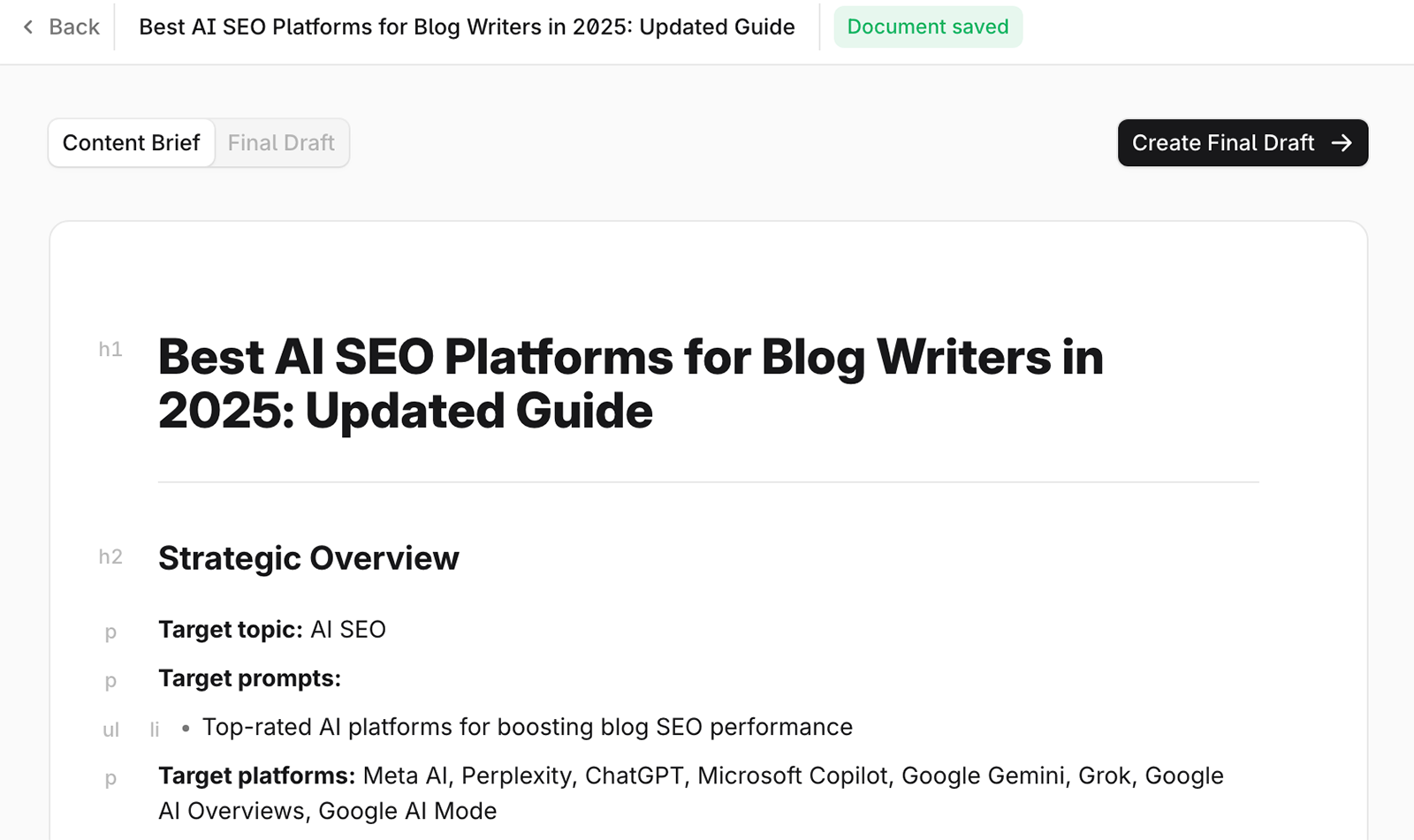
Adjust it to fit your goals and your brand. Then you can hand it off to a writer or use Profound to generate a draft and then have an editor review the content.
When generating content, Profound analyzes the most cited domains and pages for the prompt, unpacks what they do well, and conducts deep research. It creates AI-ready content that beats the competition so your brand can own the citation.
What real users say about Peec
You don’t have to take it from me. But If you’re hoping to read reviews from other Peec users, you won’t find much.
As of writing, the platform has just one G2 review. It’s a surface-level review that only mentions basic capabilities you’ll find in every other AI visibility tool on the market.
This Reddit comment offers more insight into what Peec can do compared to other AI visibility platforms like Profound. As this redditor explains, Peec is a lighter version, while Profound is a more complete and powerful option.

What real users say about Profound
In contrast, Profound has over 135 G2 reviews and a 4.6/5 rating. Reviews like this one highlight how the platform goes beyond visibility metrics to play a key role in operationalizing AI SEO strategy:
Kevin M. (CEO & Co-Founder, Mid-Market)
“It provides actionable insights you won't find elsewhere and helps operationalize strategies around AI visibility. Every action my team takes is based off of the data in this platform.”
Reviews like this mention Profound’s valuable insights, trustworthy data, and granular detail:
Rocco B. (Advertising Operations Manager, Mid-Market)
“Profound offers legitimately valuable insight on how your brand performs in AI engines and search... Profound stands out in delivering trustworthy data we can rely on.”
And reviews like this showcase Profound’s unique features—like content generation:
Abhishek R. (Senior SEO Manager, Small-Business)
“Profound has completely transformed how we approach citation tracking and sentiment analysis... What stands out most is the ability to surface regional SEO gaps at scale, something that most platforms overlook.”
How Peec AI compares to Profound
Let’s compare Peec vs. Profound side by side.
Here’s how the two platforms’ entry-level Starter plans compare:
And here’s how the two platforms’ mid-tier plans compare:
When to consider a Peec alternative like Profound
If you’re looking to monitor basic AI search analytics like visibility, position, and sentiment, Peec might be all you need. It’s designed to analyze prompts, track competitors, and identify citations that affect your brand’s AI visibility.
But if you’re looking for deeper insights and a way to put them to work, Profound is a better option. It’s designed to take the next step after research and analysis, removing the guesswork from AI visibility.
Not sure where to start with monitoring prompts? Profound has the largest dataset of real user prompts on the market, which gives you unparalleled insight into AI-driven conversations. It designs prompts for your brand so you monitor the conversations that matter.
Need a hand acting on your AI visibility analytics? Profound offers monitoring and content creation in one platform. Take advantage of opportunities using the step-by-step implementation suggestions. Or rely on Profound’s Workflows to generate content briefs and drafts to improve AI visibility.
Want to know how AI engine referral traffic performs? Profound’s Agent Analytics gives you full visibility into how AI sees your website. It connects to Google Analytics to reveal which AI bots visit your site and which pages they crawl. It also provides conversion and attribution insights so you can measure the value of your AI visibility.
Given these deep insights, strategic opportunities, and generative tools, it’s no surprise that the most innovative companies in the world rely on Profound from Ramp and Mercury to Uber and Etsy to Walmart and CVS.
If you’re ready to invest in an AI visibility platform that combines monitoring, strategic insights, and actionable workflows with options for agency and enterprise customers, Profound is the smart choice.
Get started with Profound today.